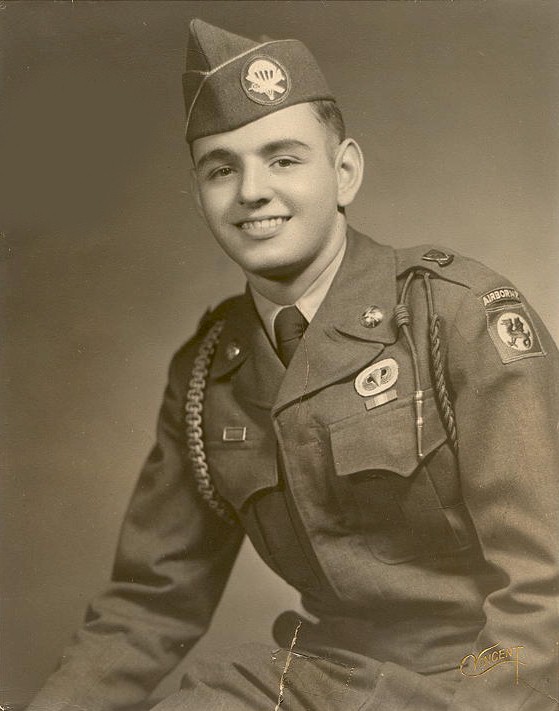Joseph Norman Grenier

Connecticut

Joseph Norman Grenier or Just "Norman" as he liked it was the second son of Adonais and Noella Despres Grenier's six children. He served in the Army during the Cold War, he was a Paratrooper in the 508th Airborne Regimental Combat Team where he was in the Heavy Weapons Platoon. Norman operated a 4.2" motar and drove an Army 4x4 truck for the weapons platoon. Norman transferred to Japan in 1955 he loved it there. To him duty in Japan was a better than the "chicken shit" army duty of the States. Here is his story:
BASIC TRAINING FORT DIX, NJNorman attended basic training at Fort Dix New Jersey. Fort Dix was named after Maj. Gen. John Adams Dix. Who, at age 14, served in the War of 1812, and later in the Civil War. He was a U.S. senator, Treasury secretary, ambassador to France, and The Governor of New York. The base was designated a permanent Army installation just prior to World War II, when it became the Fort Dix infantry basic training center. An estimated 9 million recruits have undergone training at Fort Dix. During the Second World War alone, there were approximately 3 to 5 million personnel trained there. Uncle Norman went to Basic training in August 1954. He graduated in October and transferred to Fort Campbell, Kentucky.

11TH AIRBORNE DIVISION Uncle Norman would be assigned to Fort Campbell Kentucky in the Fall of 1954. He would be assigned to the 11th airborne division which was in charge of all airborne training at that time. The 11th was activated at Camp Mackall North Carolina on February 25, 1943. The division was manned primarily with former glider troops and some veteran Airborne troops. Immediately after activation, the Division began an intensive training cycle to get all of the glider troops jump qualified. Many of the troops were simply sent up in an aircraft with little formal training on the ground. The new Airborne soldiers performed above expectations and the Division was ready for overseas movement barely a year later.
In early 1944, the Angels were ordered to prepare for embarkation and the Division moved to San Francisco California. They boarded troop transports and in May they were on their way to New Guinea in the South Pacific. Upon arrival they were ordered into an intensive training cycle to learn jungle warfare in preparation for the invasion of the Philippines. For 5 months the 11th Airborne sweated in the jungles and mountains of New Guinea and had several training jumps. Finally on November 11th, the Division boarded transports for their objective.
On November 18, 1944, the Angels landed at Leyte Beach Philippines. After consolidating their equipment, they moved inland to relieve they weary 24th Infantry and 37th Infantry Divisions. The 11th's objective was to clear a mountain pass from Burauen to Ormoc. It took 3 months of bitter fighting, often hand-to-hand to drive the Japanese defenders from the pass and surrounding heights. In the end the 11th Airborne had killed almost 6,000 enemy soldiers. When the Division arrived in Ormoc they were given a much needed rest and resupply.
On January 26, 1945 the 11th went back into action having rested only a few days. The Division landed at Nasgubu Beach, Luzon some 70 miles from the capitol city of Manila. Their mission was simple, clear all enemy opposition from a major highway and link up with the Allied forces attacking Manila. In just 5 days, the Division had eliminated all enemy resistance along Highway 17 and had pierced the main line of resistance at Tagayaty Ridge. Here the 551th Parachute Infantry Regiment conducted a combat parachute drop to reinforce the 11th and the Division continued north.
After capturing Fort McKinley, Clark field and Nichols field, the 11th launched their assult on Manila joining the 1st Cavalry Division and the 37th Infantry Division who were attacking from the North. Once the capitol was liberated, the 11th made a daring raid behind enemy lines and liberated 2,200 Allied POWs from the Los Banos Internment Camp. Once that mission was cleared the 11th Airborne spent the next few weeks mopping up resistance in the southern areas of Luzon.
In May of 1945, the Division moved into a reserve area in the Philippines to rest, resupply and take in new troops. They began preparations for the next big operation. Operation Olympic, the invasion of the Japanese home islands. Those plans were cancelled after the Japanese surrender in August 1945.
On Aug. 10, 1945, the division moved to Okinawa to escort Gen. Douglas MacArthur into Japan and to spearhead the occupation. The 11th Airborne. landed at Atsugi Airdrome, near Tokyo, on Aug. 30, 1945, and occupied an initial area in and around Yokohama. They remained there until mid-September 1945, when they moved to northern Japan and assumed responsibility for Akita, Yamagata, Miyagi and Iwate Prefectures. The division later took over control of Amori, Hokkaido, Fukushima and Prefectures to control of almost half the island of Honshu and all the island of Hokkaido.
The 11th Airborne Division remained on occupation duty until 1949 when they were relieved and sent to then Camp Campbell Kentucky. The mission of the 11th Airborne changed to that of a training division. With the outbreak of hostilities in Korea, the Division intensified its training operations and by the end of 1953, they had trained and shipped overseas some 13,000 soldiers. The 11th Airborne was sent overseas one more time, this time in 1956 to replace the 5th Infantry Division in Germany. The Division remained in Germany for the next 2 years. In 1958, the 11th Airborne was sent back to Camp Campbell where they were officially deactivated.

TRAINING AT FORT CAMPBELL Uncle Norman would train at Fort Campbell in the fall of 1954 His goal was to be a paratrooper! Paratrooper training in 1954 was rugged and very strenuous by todayís standards. But, Norman was very young, as were many of the fellow soldiers that were with him there.

Jump School at Fort Campbell, KY
Jump School was 5 weeks long. The first week was all Physical Training(PT) push-ups, sit-ups, calesthetics, etc. to top it all off was an eight mile run and if you didn't make it you were sent back to the infantry.
here is how the jump school training broke down:
1st week PT
2nd week gliders
3rd week 34' towers
4th week jump preps
5th week jump week and graduation.
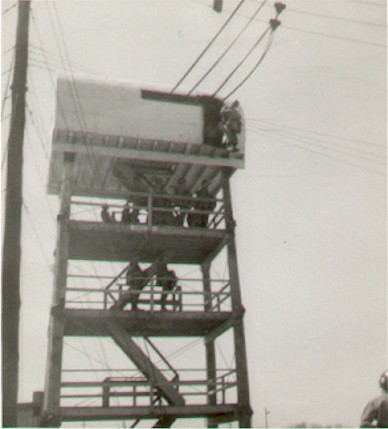
34 ft tower
THE TOWERSThe 34' towers that were used for jump training were the first hurdle that new para troopers had to overcome. Here is where many soldiers dropped out from jump training. More personnel quit at this stage that any other stage in their training. Instructors herded soldiers through the jump like cattle into a corral. Each soldier would step up to the line shout out their given number and jump.
Click here to learn more about paratroopers and their training in the 1950's
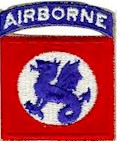
508th AIRBORNE REGIMENTAL COMBAT TEAMUpon completion of his jump school training Norman would be assigned to the 508th Airborne Regimental Combat Team. the 508th was originally formed in September 1942, MAJ Roy E. Lindquist began planning the activation of the unit he was to command. On 20 October 1942, at Camp Blanding, Florida, the 508th Infantry was born. They primarily came from the 502nd Parachute Infantry and the 26th Infantry Division. By mid-December, the 508th Parachute Infantry reached full strength. In February 1943, the regiment adopted the "Red Devil" emblem and the battle cry "Diablo" as they moved to Fort Benning for parachute training. In March, the 508th was moved to Camp Mckall, North Carolina, where they trained until December.
On 28 December 1943, the regiment boarded the U.S. Army Transport James Parker and set out to join the convoy across the Atlantic for WWII. On 9 January 1944, the James Parker docked at Belfast, Ireland and the 508th commenced training throughout Great Britain. During Operation Overlord, the regiment was responsible for the Southwest portion of the 82d Airborne Division sector in Normandy. Their primary targets were bridges over the Douve River, located at Brienville and Beuzeville-la-Bastille. Clouds and heavy anti-aircraft fire caused the formations to break up and many of the planes to stray off course. Despite these obstacles, 2056 Red Devils jumped into Normandy on 6 June 1944. The paratroopers hit the ground, assembled into small groups, and started establishing themselves in the most strategic positions possible. The regiment focused on three particular targets: the bridges over the Mederet River at La Fiere and Chef-du-Pont, and Hill 30, and a small knoll on the west bank of the Mederet. On 12 June 1944, the regiment moved out to drive further into "Hitlerís Fortress Europe." On 13 July 1944, the Red Devils returned to England after suffering 1,161 casualties out of 2,056 paratroopers.
At approximately 1330 hours on 17 September 1944, the Red Devils jumped into Holland as part of Operation Market Garden. Although initial resistance was light, heavy fighting followed for days. In November, the regiment returned to England for another rest, but soon found itself on 16 December 1944 in Ardennes. The 508th found itself against 12 German divisions in the famous "Battle of the Bulge". On 29 January 1945, the First Sergeant Leonard Funk earned the Medal of Honor for rescuing approximately 10 paratroopers from German capture by killing over 45 German soldiers and wounding the rest. As a result, President Harry Truman awarded the Congressional Medal of Honor to Leonard Funk.

The 508th returned home on 24 November 1946, and was later inactivated at Camp Kilmer, New Jersey. The 508th was reactivated in April 1951 as the 508th Airborne Regimental Combat Team it tranferred from Ft Benning Georgia to Ft Campbell, KY in 1954 . The regiment was transferred again in July 1955 to Beppu, Japan for "Operation Gyroscope" then it was transferred back to Fort Campbell in 1957 deactivated.

The C-124 Globemaster
OPERATION GYROSCOPE Upon completion of his training in Fort Campbell, Uncle Norman would remain ther for a few months until July 1955 when he would take part in an Army first. Norman along with the rest of his unit would load up in C-124 Globemasters and fly all the way to Japan to relieve the 187th Airborne Regimental Combat Team, the "Rakasans". This had never been done before, moving an entire regiment all at once. Usually when the Army transferred personnel they did it one at a time. During "Operation Gyroscope" one C-124 left Fort Campbell every hour with one full Company (and all their records/equipment, etc.) Once in the air they had a six hour flight to Travis AFB in California to refuel, eat and grab a box lunch for the next leg of the journey to Hickam AFB, Hawaii. From there they flew on to Wake Islandin the Pacific Ocean. After refueling and grabbing some more chow for the third time, they proceeded to Ashiya Airbase, Japan. It took three whole days just to get there. At Ashiya they boarded a train for the trip to the town of Beppu, a port city on the Island of Kyushu (southern most Island of Japan)

Map of Japan; Beppu and Kumomoto are in shown in the insert
"CAMP CHICKAMAUGA" BEPPU, JAPAN "Camp Chickamauga" was located just above the city of Beppu in the provence of Kumomoto, It had been a Japanese Army base during WW II. The climate on the southern island was moderate. Winters were fair not too cold, with a light dusting of snow every now and then. The mountains close by always got hevy snowfall on the peaks. Summers were very warm but not extreme. Life at the base was the same as in any Army camp.

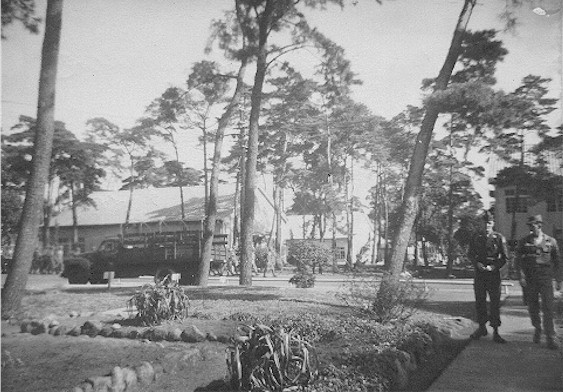 The barracks on the base were similiar to those in the United States, two story rectangular buildings that were in better condition than the barracks in Fort Campbell and other army posts. The Japanese people were very friendly and the base had many W.W.II Japanese veterans working as Cooks helpers, Supply room helpers, and maintainance personnel. There was an amusement park between Beppu and Oita, called "Monkey Mountain" by the GI's. Hot springs which came out of the mountain was piped into most if not all homes and hotels in Beppu. There was a very steep cable car that went up the mountain to a resort about 1/2 mile. The GI's could eat at a nice restaurant, or take a hot spring bath. Most GI's had to cool down the baths with cold water just to get in because teh water was so hot. Food stands and canteens were abundant. The Japanese cooked on hot vents coming right out of the springs.
The barracks on the base were similiar to those in the United States, two story rectangular buildings that were in better condition than the barracks in Fort Campbell and other army posts. The Japanese people were very friendly and the base had many W.W.II Japanese veterans working as Cooks helpers, Supply room helpers, and maintainance personnel. There was an amusement park between Beppu and Oita, called "Monkey Mountain" by the GI's. Hot springs which came out of the mountain was piped into most if not all homes and hotels in Beppu. There was a very steep cable car that went up the mountain to a resort about 1/2 mile. The GI's could eat at a nice restaurant, or take a hot spring bath. Most GI's had to cool down the baths with cold water just to get in because teh water was so hot. Food stands and canteens were abundant. The Japanese cooked on hot vents coming right out of the springs.

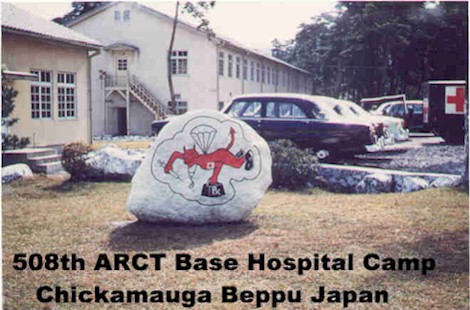
JUMPING IN JAPAN
The 508th practiced their "Jumps" at Oita a town about 15 miles south of Beppu. Oita had been a Japanese fighter base during the war, some of the old buildings and concrete runways were still there but the American C-47's used a grass strip next to it. The base had been badly damaged by the B-29's during the war and hadn't been fixed. The C-47's used by the 508th had French markings on them, they were recently returned from the French Army. The C-47's were the same planes the French used to drop French paratroopers into the disaterous Dien-Bien-Phu campaign in Vietnam.
 One day the 508th would depart Oita Air Base and fly off the Oita Peninsula. With the river on one side and the ocean on the other two, the 508th would jump. The 508th's Jump markers were floats in the middle of the river. One story of a casualty was a trooper from the 187th "Rakkasans" landed in the river with full gear. His boots got stuck in the mud on the river bottom and he drowned. After that tragedy paratroopers wore inflatable life vests under their chutes, these 5 x 6 little square vests one under each arm, would inflate and would force a man to float head up and out of the water.
One day the 508th would depart Oita Air Base and fly off the Oita Peninsula. With the river on one side and the ocean on the other two, the 508th would jump. The 508th's Jump markers were floats in the middle of the river. One story of a casualty was a trooper from the 187th "Rakkasans" landed in the river with full gear. His boots got stuck in the mud on the river bottom and he drowned. After that tragedy paratroopers wore inflatable life vests under their chutes, these 5 x 6 little square vests one under each arm, would inflate and would force a man to float head up and out of the water.

Norman would transfer back to the States in the Summer of 1956 he would take an early release from the Army and return to Norwalk Connecticut where he lived until his death. His wife Christine still lives in the same house they owned since 1965. I have many memories of that house. He passed away in December 2004 from lung cancer. He is survived by his wife and two daughters Jane and Theresa - with 6 Grandchildren and two Great Grandchildren. He will be greatly missed by all.
HOME
